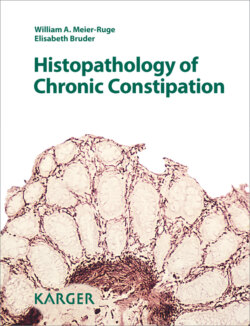Читать книгу Histopathology of Chronic Constipation - W.A. Meier-Ruge - Страница 8
На сайте Литреса книга снята с продажи.
Оглавление
Histopathological Diagnosis
A.1
Enzyme Histochemical Differential Diagnosis in Chronic Constipation
When enzyme histochemistry is mentioned, the question arises: ‘Why is HE (hemalum-eosin) staining in formalin-fixed tissue not enough?’
Enzyme histochemistry is a morphological technique which gives first-time functional information [9-12]. It is an important link to conventional histology, immunohistochemistry, and molecular pathology. It offers orthoptic localization of a particular enzyme in nerve cells and nerve fibers, as well as parenchymal cells, and reflects the metabolic rate of a particular cell by enzymes of the citric cycle. In contrast to other methods which only give static information, enzyme histochemistry is a sensitive and dynamic method which demonstrates a metabolic imbalance in pathological processes [9-12]. Enzyme histochemistry offers insights in the pathophysiology of HD and other diseases.
Figure 1 demonstrates in which way conventional histological staining relates to enzyme histochemistry.
Besides lactic dehydrogenase (LDH) and succinic dehydrogenase (SDH), which are used in the diagnosis of muscle biopsies, acetylcholinesterase (AChE) is routinely used in standard pathological laboratories as a key reaction in HD [13].
Fig. 1. Schematic representation of conventional staining (left) and enzyme histochemistry (right). Both techniques function complementarily. Conventional HE staining delineates the different tissue compartments and is a technique of static pathology. Enzyme histochemistry highlights functional alterations and elucidates the pathophysiology of a particular disease.
Rudolf Virchow postulated 160 years ago that the aim of pathological diagnostic research is the recognition of the pathophysiology of a particular disease [14, 15]. Enzyme histochemistry is the first morphologic method able to give insights into the pathophysiology of a particular disease [9, 16-18], and has proven to be the technique of choice in the diagnostic of gastrointestinal motility disorders [9, 18-21].
A.2
Functional Histopathological Differential Diagnosis in Colonic Motility Disorder
It has been demonstrated in recent years that a high number of different anomalies of the myenteric plexus or submucous plexus and smooth muscles of the lamina propria cause chronic constipation [2, 4, 13, 22].
Differential diagnosis of chronic constipation contains a high number of different diseases, which require different therapeutic strategies. These diseases include:
• HD
• Ultrashort HD
• Sphincter achalasia
• Total colonic aganglionosis
• Hypoganglionosis
• Immaturity of the enteral nervous system of mature babies
• Architectural malformation of the muscularis propria
• Atrophic alterations of the muscularis propria
• Intestinal neuronal dysplasia type A (NEC)
• Intestinal neuronal dysplasia type B
• Multiple endocrine neoplasia 2B
• Aplastic desmosis of the muscularis propria
• Atrophic desmosis of the muscularis propria
• Degenerative myopathy
